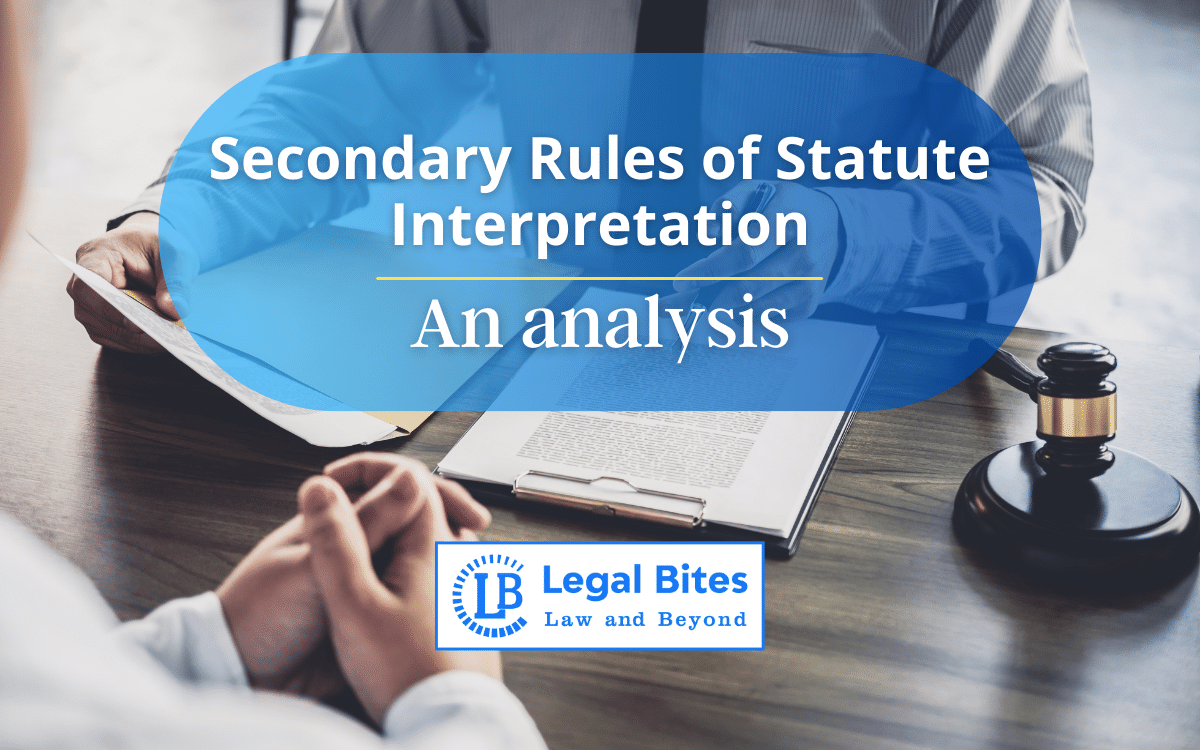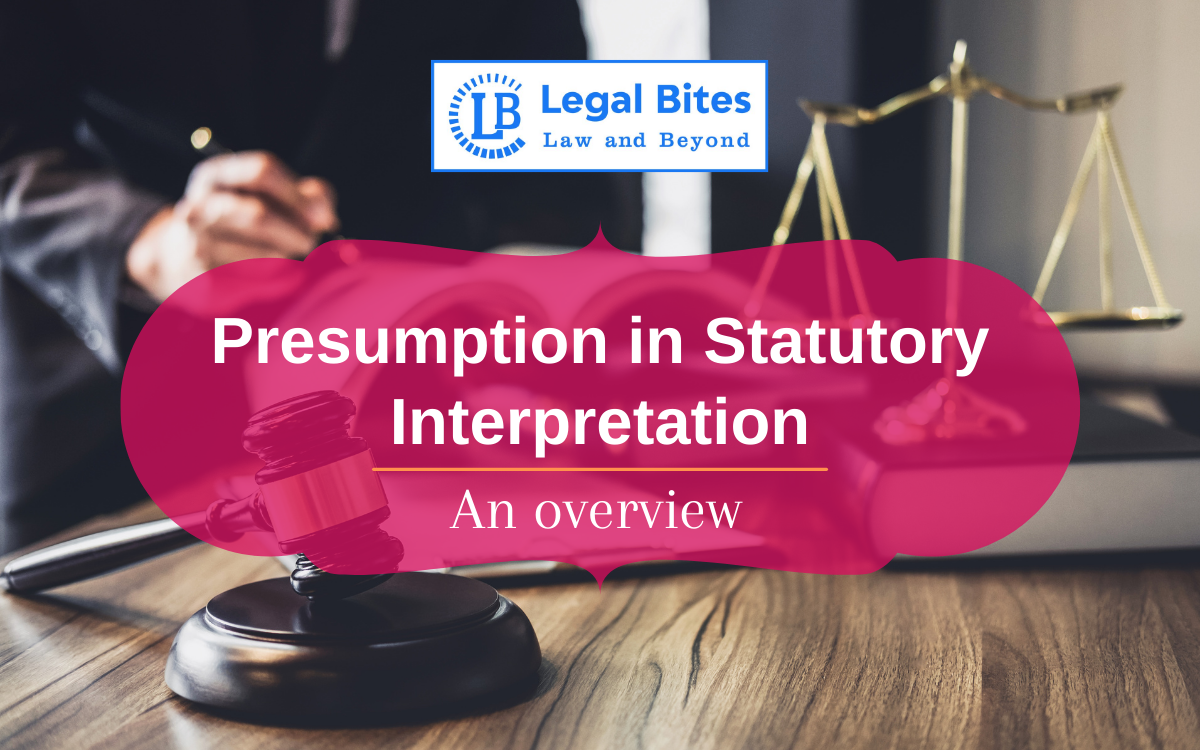Secondary Rules of Statute Interpretation: An analysis
Explore Ejusdem Generis, Noscitur a Sociis, and Expressio Unius—key rules of statutory interpretation with definitions, case laws, and legal analysis.;

Statutory interpretation is the process by which courts determine the meaning of legislation. While the primary rules—literal, golden, and mischief—form the foundation of interpretation, secondary or subsidiary rules play a vital role in resolving ambiguities where primary rules are insufficient. These secondary rules include ejusdem generis, noscitur a sociis, and expressio unius est exclusio alterius. These Latin maxims help decode legislative intent when faced with unclear...
Statutory interpretation is the process by which courts determine the meaning of legislation. While the primary rules—literal, golden, and mischief—form the foundation of interpretation, secondary or subsidiary rules play a vital role in resolving ambiguities where primary rules are insufficient. These secondary rules include ejusdem generis, noscitur a sociis, and expressio unius est exclusio alterius. These Latin maxims help decode legislative intent when faced with unclear statutory language, ensuring the interpretation aligns with the purpose and structure of the law.
This article explores the legal significance, application, limitations, and judicial pronouncements concerning these three secondary rules of interpretation.
I. Ejusdem Generis
Meaning and Origin
Ejusdem generis means "of the same kind or nature." When general words follow specific words in a statute, the general words are interpreted to include only items of the same type as those listed specifically.
Rule Structure
To invoke ejusdem generis, the following conditions must be met:
- The statute contains a list of specific items.
- A general word or phrase follows the list.
- The specific items belong to a recognizable class or category.
For example, in the phrase “cars, trucks, tractors, and other vehicles”, the term “other vehicles” will be interpreted to include similar motorised vehicles, excluding items like bicycles or airplanes.
In Amar Chandra Chakraborty v. Collector of Excise (1972 AIR 1863), the Supreme Court of India emphasized that ejusdem generis can be applied only when the preceding words form a distinct genus.
Similarly, in Jage Ram v. State of Haryana (AIR 1971 SC 1033), the Court held that unless a clear genus is formed, the general term should not be restricted.
Limitations
- The rule cannot override the clear intention of the legislature.
- It is inapplicable where the context suggests a broader interpretation.
- It does not apply if there is no common class or category among specific words.
Statutory Example: Section 2(h) of the Indian Contract Act, 1872 defines a contract to mean an agreement enforceable by law. If a section defined "instruments" as including "wills, deeds, and other documents," ejusdem generis would require that "other documents" be interpreted in line with "wills" and "deeds" (formal, legal documents).
II. Noscitur a Sociis
Meaning and Concept
Noscitur a sociis means "a word is known by the company it keeps." This rule suggests that the meaning of an ambiguous word or phrase should be determined by the context in which it appears, especially by examining surrounding words.
Legal Significance
The maxim is particularly useful when a word is susceptible to multiple interpretations. It helps the court deduce the intent of the legislature based on the word's association with others in the same provision.
In RBI v. Peerless General Finance & Investment Co. Ltd. (1987 AIR 1023), the Supreme Court stated:
“Interpretation must depend on the text and the context. They are the bases of interpretation. One may well say if the text is the texture, context is what gives the colour.”
In State of Bombay v. Hospital Mazdoor Sabha (AIR 1960 SC 610), the Court interpreted the word "industry" in light of its surrounding expressions to determine the legislative intent under the Industrial Disputes Act, 1947.
Application Example: Suppose a law refers to “temples, mosques, churches, and other places”. Using noscitur a sociis, "other places" would be understood to refer only to places of religious worship.
Limitations
- It cannot be applied to contradict a clear and unambiguous word.
- The presumption of contextual meaning must yield to the object of the statute.
Statutory Use: Section 3(42) of the General Clauses Act, 1897 defines “person” to include any company or association or body of individuals. If the statute continues with "whether incorporated or not," noscitur a sociis may guide how far the inclusion extends based on the form and nature of the entities listed.
III. Expressio Unius Est Exclusio Alterius
Meaning and Interpretation
Expressio unius est exclusio alterius means "the express mention of one thing excludes all others." This rule implies that when a statute specifically lists certain things, it is presumed that omissions are intentional and no additions should be made by implication.
This maxim is rooted in legislative precision. If the legislature intended something else to be included, it would have been expressly mentioned.
In G.P. Singh v. Union of India (AIR 1991 SC 442), the Court applied this maxim while interpreting provisions of the Constitution and clarified that what is not explicitly stated should not be read into the statute.
In Taylor v. Taylor [(1876) 1 Ch D 426], the English Court held that where a statute provides a particular method of doing something, that method must be followed exclusively.
In State of U.P. v. Singhara Singh (AIR 1964 SC 358), the Supreme Court held that when a statute lays down a particular mode for recording confessions, other modes are impliedly prohibited.
If a statute says, “No person shall carry a weapon except police officers and members of the armed forces,” this would exclude private security guards, even if they are not expressly prohibited.
Exceptions and Limitations
- It is a presumption and not a rigid rule.
- It cannot override the clear intention of the legislature.
- Courts may interpret inclusively if required by the context or purpose of the statute.
In Hari Krishna Mandir Trust v. State of Maharashtra [(2020) 9 SCC 356], the Court relied on this maxim while interpreting the scope of statutory authority granted under the Maharashtra Regional and Town Planning Act.
Comparative Analysis of the Three Rules
| Rule | Meaning | Use Case | Limitation |
|---|---|---|---|
| Ejusdem Generis | General words take color from specific ones | Used when general words follow specific terms | Needs a clear genus |
| Noscitur a Sociis | Meaning of a word determined by surrounding words | Resolves ambiguity by context | Cannot contradict a clear word |
| Expressio Unius | Mention of one excludes others | Infers legislative intent from inclusion | Not absolute; context may differ |
These maxims serve complementary roles in refining statutory interpretation. While ejusdem generis and noscitur a sociis both operate on contextual understanding, expressio unius focuses on deliberate omission.
Relevance in Modern Statutory Interpretation
In today’s legislative environment, where statutes are often detailed and complex, secondary rules of interpretation play a critical role in clarifying legislative intent. However, courts have reiterated that these are mere tools, not inflexible doctrines.
Justice G.P. Singh, in his authoritative book Principles of Statutory Interpretation, notes that:
“These maxims must yield to the purpose of the statute. Where the plain words of the statute are clear, these rules must not be allowed to cloud interpretation.”
Moreover, the Indian judiciary has adopted a purposive approach, especially in constitutional and welfare legislations, often setting aside strict literalism in favour of the objective and scheme of the law.
Conclusion
The secondary rules of interpretation—ejusdem generis, noscitur a sociis, and expressio unius est exclusio alterius—are essential tools in judicial reasoning. They help prevent misapplication of legislative texts and ensure laws are interpreted in harmony with their context, structure, and purpose. However, courts must apply these principles judiciously, ensuring they aid rather than hinder the legislative intent. As statutory language becomes increasingly nuanced, the relevance of these interpretative aids will continue to grow in ensuring justice and consistency in legal interpretation.
References
- G.P. Singh, Principles of Statutory Interpretation, 14th Ed., LexisNexis, 2016.
- Amar Chandra Chakraborty v. Collector of Excise, AIR 1972 SC 1863.
- Jage Ram v. State of Haryana, AIR 1971 SC 1033.
- RBI v. Peerless General Finance & Investment Co. Ltd., AIR 1987 SC 1023.
- State of Bombay v. Hospital Mazdoor Sabha, AIR 1960 SC 610.
- G.P. Singh v. Union of India, AIR 1991 SC 442.
- Taylor v. Taylor, (1876) 1 Ch D 426.
- State of U.P. v. Singhara Singh, AIR 1964 SC 358.
- Hari Krishna Mandir Trust v. State of Maharashtra, (2020) 9 SCC 356.
- P.M. Bakshi, Interpretation of Statutes, 3rd Ed., Universal Law Publishing, 2015.
Important Link





